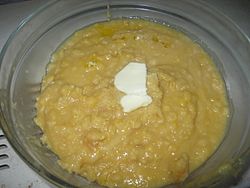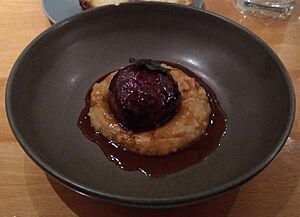Pease pudding facts for kids

Pea puree
|
|
| Alternative names | Pease pottage, pease porridge, pea and ham soup |
|---|---|
| Type | Pudding |
| Place of origin | England |
| Main ingredients | Split yellow peas, water, salt, spices |
Pease pudding, also known as pease porridge, is a tasty dish. It's a type of pudding made from cooked legumes. Most often, it uses split yellow peas.
People mix the peas with water, salt, and spices. Sometimes, it's even cooked with a piece of bacon or ham. This dish is very popular in the north-east of England. You can also find it in other parts of Britain and around the world.
Contents
What is Pease Pudding?

Pease pudding is usually thick. Its texture is a bit like hummus, but it's a little firmer. It has a light yellow color and a mild flavor.
This dish is a long-standing tradition in England. It's especially common in the industrial areas of North East England, like South Shields.
How is it served?
People often eat pease pudding with ham or bacon. It also goes well with beetroot and special stottie cakes. It's a key ingredient in a classic saveloy dip too.
In Southern England, it's often served with faggots. There's even a small village called Pease Pottage in Southern England. People say it got its name because it used to serve pease pudding to travelers.
Other Pea Dishes
In the north of Scotland, there's a breakfast dish called peasemeal brose. It's made in a traditional way. People usually eat it with butter, and either salt or honey.
In some parts of the Midlands, pease pudding is served with fish and chips. It's used instead of mushy peas. The main difference is often the name and that mushy peas are usually green. Both use "field peas," which are harvested dry. "Sweet peas" are the same plant, but picked fresh.
Pease Pudding Around the World
Pease pudding has different versions in many countries. It's a traditional part of Jiggs dinner in Newfoundland, Canada.
German Variations
In German-speaking countries, pease pudding is called Erbspüree or Erbsenpüree. You might also hear it called Erbsbrei or Erbsmus. It's very popular in the traditional food of Berlin, Germany's capital.
A well-known German dish served with pease pudding is Eisbein. This is a type of pork hock. A similar dish with ham hock, called karka, is served in Lithuania.
Russian and Chinese Dishes
Traditional Russian cuisine has several pea dishes. These include pea pudding or purees. They are known as gorohovaya kasha (гороховая каша) or goroshnitsa (горошница).
In Beijing cuisine, there's a dish called Wandouhuang (豌豆黄). This is a sweet and cold pease pudding. It's made with yellow split peas or shelled mung beans. Sometimes, it's flavored with sweet osmanthus flowers and dates. It's said that a fancy version of this snack was a favorite of Empress Dowager Cixi.
Greek Fava
In Greek cuisine, a similar dish is called Fava (Φάβα). Even though it's called Fava, it's usually made from yellow split peas. It does not use Fava beans. People usually drizzle the mashed peas with olive oil. They also top it with chopped raw onions.
How to Make Pease Pudding
Making pease pudding usually starts with soaking split yellow peas. Then, you cook them in stock. Traditionally, people use ham hock stock. They cook the peas for about 40 minutes until they are soft.
After cooking, the peas become a mush. This mush is then blended with other ingredients. The exact ingredients can change depending on the recipe. Some old recipes for similar dishes used saffron, nutmeg, and a little cinnamon. Modern recipes sometimes add an egg. The egg helps to bind the pudding together.

